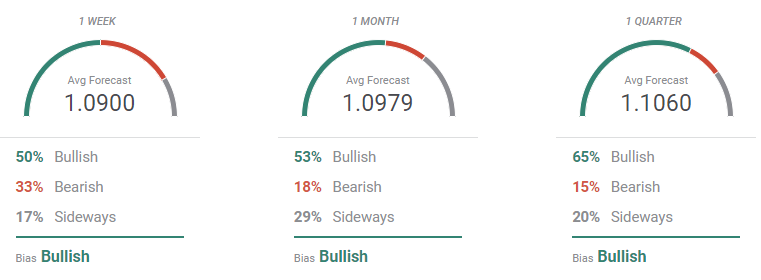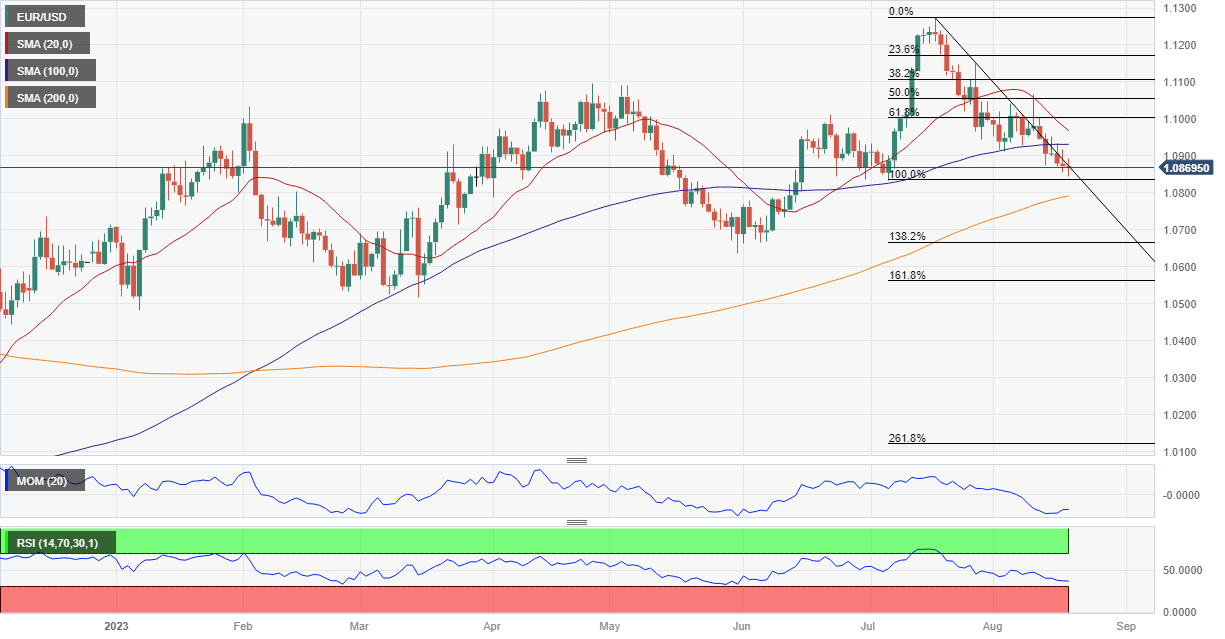- The United States will host the Jackson Hole Symposium next week, eyes on monetary policies’ clues.
- Euro Zone data spells trouble, fueling the risk of a steeper economic downturn.
- EUR/USD bearish case remains firmly in place, with chances of testing 1.0700 increasing.
The EUR/USD pair extended its monthly decline, ending the week a handful of pips above the July low at 1.0833. Without much relevant macroeconomic data to care off, financial markets kept their eyes on China, and woes in the real-estate sector dragging the already tepid economic progress.
China in the eye of the storm once again
Alarms were triggered over the weekend when Country Garden, a prominent real estate developer, announced it could not repay its loans. As the days went by, another company, Zhongrong International Trust, failed to make payments on its bonds. The trust company is considered a “shadow” bank, and fears of a financial meltdown arose, with protests in Beijing.
Local authorities tried to cold down fears to prevent a steeper crisis. “The risks of housing enterprises are expected to be gradually resolved,” said Fu Linghui of the Chinese National Bureau of Statistics. Furthermore, the government was reportedly selling US Dollars in the spot market to boost Yuan’s value.
The risk of global contagion is low, although the headlines were enough to spur risk aversion. The US Dollar retained its leadership across the FX board, despite shedding some ground along the way.
Europe not out of the woods
The Euro Zone delivered some interesting figures these last few days. On the one hand, the EU unveiled the second estimate of the Q2 Gross Domestic Product (GDP), which confirmed the economy grew 0.3% in the three months to June. On Friday, the EZ confirmed the July Harmonized Index of Consumer Prices (HICP) rate at 5.3% in July, slowing further from record peaks posted mid-2022. According to Eurostat, the core annual HICP inflation printed at 5.5%, as previously estimated.
While encouraging, the news showed growth is stagnating, while price pressures continue well above the European Central Bank (ECB) comfort level of 2%. The central bank has pushed the main refinancing rate to 4.25% and is likely to hike further this year, regardless of the risks of a steeper economic setback. A tight labor market negatively adds to the fragile situation.
United States doing better
United States (US) data published these days was far more encouraging. Retail Sales unexpectedly rose by 0.7% in June, while Industrial Production was up 1% in July. News from the housing sector were also upbeat, as Housing Started jumped 3.9% while Building Permits were up 0.1% in July. Finally, Initial Jobless Claims printed at 239K in the week ended August 11, better than the 240K expected.
More relevantly, the Federal Open Market Committee (FOMC) published the Minutes of the August meeting, when the central bank decided to hike the benchmark rate by 25 basis points (bps). The document was read as hawkish, as policymakers remarked on the continued risks related to inflation, leaving the door open for additional increases. As widely anticipated, policymakers noted future monetary policies would be data-dependant. Fed officials’ comments further fueled the dismal mood, pushing EUR/USD below 1.0900.
Growth figures and Jackson Hole
S&P Global will publish the preliminary estimates of the August PMIs next Wednesday. In the EU, the focus will be on the manufacturing sector, as contraction in the area has been steepening in the last few months. Services output is also foreseen retreating, although mostly holding into expansion territory. A similar picture is expected in the US, with the Manufacturing PMI currently at 49 and the Services index at 52.3.
The US will also publish July Durable Goods Orders next week, while Germany will release the second estimate of the Q2 GDP, previously estimated at 0%QoQ.
Finally, investors will keep an eye on the Jackson Hole Symposium starting next Thursday. The event will feature comments from global central banks, but investors will be waiting for Fed Chair Jerome Powell, who will speak on Friday. Market players will be looking for Powell to shed some light on the monetary policy's future. Still, Powell will likely reiterate the data-dependent approach and repeat that rates will remain high for longer to tame inflation.

EUR/USD technical outlook
The EUR/USD pair has been on the back foot ever since hitting 1.1275 on July 18. It has closed in the red for five consecutive weeks, and it stands on the brink of piercing the July monthly low at 1.0833. Nevertheless, there are no signs of downward exhaustion in the long term. On the contrary, it seems the pair could accelerate its slump in the mid-term.
The weekly chart shows that the pair met buyers around a flat 20 Simple Moving Average (SMA), capping the upside at around 1.0930. At the same time, the pair keeps developing above a bearish 100 SMA at 1.0774, a potential bearish target for the upcoming days. Finally, the Momentum indicator seesaws around its midline, lacking directional strength, while the Relative Strength Index (RSI) indicator heads firmly south at around 50, anticipating a continued slide.
Technical readings in the daily chart for the EUR/USD pair also skew the risk to the downside. The pair posts lower lows and lower highs on a regular basis, while long upward ticks in the daily candles suggest that sellers are happily adding shorts on spikes. Furthermore, the pair slid below a now flat 100 SMA, meeting resistance around it throughout the week. At the same time, the 20 SMA maintains a firmly bearish slope above the longer one, reflecting the dominant trend. Finally, technical indicators remain within negative levels, with the Momentum lacking directional strength but the RSI extending its decline towards oversold territory.
Support can be found at 1.0830 and the 1.0770 areas, while below the latter, the slide can continue towards 1.0700. Given the steady decline, a corrective advance is not out of the table. The levels to watch to the upside are 1.0930 and the 1.1000 threshold, although as long as the pair remains below the latter, the bearish case will remain strong.
EUR/USD sentiment poll
According to the FXStreet Forecast Poll, the EUR/USD pair may have a chance to recover. Market players do not expect a steeper decline but instead maintain their bullish stance. Buyers dominate the three time frames under study, increasing in time from 50% in the weekly view to 65% in the quarterly one. In contrast, bears shrink from 33% to 15%. On average, the pair is seen holding above 1.0900, picking up in term. In the quarterly view, EUR/USD is seen at 1.1060.
Meanwhile, the Overview chart offers a mostly neutral stance. The weekly moving average turned marginally lower, as most targets accumulate around 1.0800, but the longer moving averages remain flat. In the monthly perspective, most targets accumulate below the 1.1000 threshold, but in the quarterly view, are above such a level, in line with a Euro comeback.

Information on these pages contains forward-looking statements that involve risks and uncertainties. Markets and instruments profiled on this page are for informational purposes only and should not in any way come across as a recommendation to buy or sell in these assets. You should do your own thorough research before making any investment decisions. FXStreet does not in any way guarantee that this information is free from mistakes, errors, or material misstatements. It also does not guarantee that this information is of a timely nature. Investing in Open Markets involves a great deal of risk, including the loss of all or a portion of your investment, as well as emotional distress. All risks, losses and costs associated with investing, including total loss of principal, are your responsibility. The views and opinions expressed in this article are those of the authors and do not necessarily reflect the official policy or position of FXStreet nor its advertisers. The author will not be held responsible for information that is found at the end of links posted on this page.
If not otherwise explicitly mentioned in the body of the article, at the time of writing, the author has no position in any stock mentioned in this article and no business relationship with any company mentioned. The author has not received compensation for writing this article, other than from FXStreet.
FXStreet and the author do not provide personalized recommendations. The author makes no representations as to the accuracy, completeness, or suitability of this information. FXStreet and the author will not be liable for any errors, omissions or any losses, injuries or damages arising from this information and its display or use. Errors and omissions excepted.
The author and FXStreet are not registered investment advisors and nothing in this article is intended to be investment advice.
Recommended Content
Editors’ Picks

Gold price taps $3,300; fresh record high amid trade war concerns and weaker USD
Gold price continues scaling new record highs through the Asian session on Wednesday and has now moved well within striking distance of the $3,300 round-figure mark. Persistent worries about the escalating US-China trade war and US recession fears amid the ongoing US tariff chaos continue to boost demand for gold.

EUR/USD holds firm above 1.1350 amid renewed US Dollar weakness
EUR/USD is storngly bid above 1.1350 in European trading on Wednesday. The pair draws support from a fresh round of selling in the US Dollar amid persistent fears over US-China trade war and a lack of progress on EU-US trade talks. US consumer data and Powell speech are in focus.

GBP/USD trades at fresh 2025-high above 1.3250 after UK CPI data
GBP/USD builds on its six-day winning streak and trades at its highest level since October above 1.3250 in the European session on Wednesday. The data from the UK showed that the annual CPI inflation softened to 2.6% in March from 2.8% in February but had little impact on Pound Sterling.

Exchange inflows surge as XRP slides, what comes next?
Ripple corrected along with other major digital assets, including Bitcoin and Ethereum, and traded at $2.08 at the time of writing on Wednesday. The drawdown cut across the crypto market, causing the total capitalization to drop 3.2% to $2.736 trillion.

Is a recession looming?
Wall Street skyrockets after Trump announces tariff delay. But gains remain limited as Trade War with China continues. Recession odds have eased, but investors remain fearful. The worst may not be over, deeper market wounds still possible.

The Best brokers to trade EUR/USD
SPONSORED Discover the top brokers for trading EUR/USD in 2025. Our list features brokers with competitive spreads, fast execution, and powerful platforms. Whether you're a beginner or an expert, find the right partner to navigate the dynamic Forex market.
